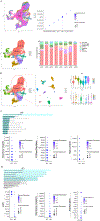Single-cell RNA sequencing in silent corticotroph tumors confirms impaired POMC processing and provides new insights into their invasive behavior
- PMID: 35521707
- PMCID: PMC9248914
- DOI: 10.1530/EJE-21-1183
Single-cell RNA sequencing in silent corticotroph tumors confirms impaired POMC processing and provides new insights into their invasive behavior
Abstract
Objective: Provide insights into the defective POMC processing and invasive behavior in silent pituitary corticotroph tumors.
Design and methods: Single-cell RNAseq was used to compare the cellular makeup and transcriptome of silent and active corticotroph tumors.
Results: A series of transcripts related to hormone processing peptidases and genes involved in the structural organization of secretory vesicles were reduced in silent compared to active corticotroph tumors. Most relevant to their invasive behavior, silent corticotroph tumors exhibited several features of epithelial-to-mesenchymal transition, with increased expression of mesenchymal genes along with the loss of transcripts that regulate hormonal biogenesis and secretion. Silent corticotroph tumor vascular smooth muscle cell and pericyte stromal cell populations also exhibited plasticity in their mesenchymal features.
Conclusions: Our findings provide novel insights into the mechanisms of impaired POMC processing and invasion in silent corticotroph tumors and suggest that a common transcriptional reprogramming mechanism simultaneously impairs POMC processing and activates tumor invasion.
Conflict of interest statement
Figures






Similar articles
-
Why don't corticotroph tumors always produce Cushing's disease?Eur J Endocrinol. 2019 Sep;181(3):351-361. doi: 10.1530/EJE-19-0338. Eur J Endocrinol. 2019. PMID: 31319379
-
Inhibitory effects of SOM230 on adrenocorticotropic hormone production and corticotroph tumor cell proliferation in vitro and in vivo.Mol Cell Endocrinol. 2014 Aug 25;394(1-2):37-46. doi: 10.1016/j.mce.2014.07.001. Epub 2014 Jul 8. Mol Cell Endocrinol. 2014. PMID: 25011056
-
In situ hybridization study of pro-opiomelanocortin (POMC) gene expression in human pituitary corticotrophs and their adenomas.Virchows Arch A Pathol Anat Histopathol. 1991;419(2):107-13. doi: 10.1007/BF01600224. Virchows Arch A Pathol Anat Histopathol. 1991. PMID: 1651583
-
Nuclear Receptors as Regulators of Pituitary Corticotroph Pro-Opiomelanocortin Transcription.Cells. 2020 Apr 7;9(4):900. doi: 10.3390/cells9040900. Cells. 2020. PMID: 32272677 Free PMC article. Review.
-
[Pathology and pathogenesis of pituitary corticotroph adenoma].Neurochirurgie. 2002 May;48(2-3 Pt 2):149-62. Neurochirurgie. 2002. PMID: 12058122 Review. French.
Cited by
-
Refractory corticotroph adenomas.Pituitary. 2023 Jun;26(3):269-272. doi: 10.1007/s11102-023-01308-5. Epub 2023 Mar 14. Pituitary. 2023. PMID: 36917358 Free PMC article. Review.
-
Tumour microenvironment and pituitary tumour behaviour.J Endocrinol Invest. 2023 Jun;46(6):1047-1063. doi: 10.1007/s40618-023-02089-1. Epub 2023 Apr 15. J Endocrinol Invest. 2023. PMID: 37060402 Review.
-
Comprehensive mapping of somatotroph pituitary neuroendocrine tumour heterogeneity using spatial and single-cell transcriptomics.Clin Transl Med. 2024 Nov;14(11):e70090. doi: 10.1002/ctm2.70090. Clin Transl Med. 2024. PMID: 39548559 Free PMC article.
-
A Bridge Too Far? Towards Medical Therapy for Clinically Nonfunctioning Pituitary Tumors.Int J Mol Sci. 2025 Jun 19;26(12):5898. doi: 10.3390/ijms26125898. Int J Mol Sci. 2025. PMID: 40565361 Free PMC article. Review.
-
Cellular mechanisms of hormone secretion in neuroendocrine tumors: what goes wrong?Front Cell Dev Biol. 2025 Jul 1;13:1527083. doi: 10.3389/fcell.2025.1527083. eCollection 2025. Front Cell Dev Biol. 2025. PMID: 40666287 Free PMC article. Review.
References
-
- Alahmadi H, Lee D, Wilson JR, Hayhurst C, Mete O, Gentili F, Asa SL, Zadeh G. Clinical features of silent corticotroph adenomas. Acta neurochirurgica. 2012;154(8):1493–8. - PubMed
-
- Saeger W, Lüdecke DK, Buchfelder M, Fahlbusch R, Quabbe HJ, Petersenn S. Pathohistological classification of pituitary tumors: 10 years of experience with the German Pituitary Tumor Registry. European journal of endocrinology. 2007;156(2):203–16. - PubMed
-
- Raverot G, Wierinckx A, Jouanneau E, Auger C, Borson-Chazot F, Lachuer J, Pugeat M, Trouillas J. Clinical, hormonal and molecular characterization of pituitary ACTH adenomas without (silent corticotroph adenomas) and with Cushing’s disease. European journal of endocrinology. 2010;163(1):35–43. - PubMed
-
- Flores L, Sleightholm R, Neilsen B, Baine M, Drincic A, Thorell W, Shonka N, Oupicky D, Zhang C. Highly Aggressive and Radiation-Resistant, “Atypical” and Silent Pituitary Corticotrophic Carcinoma: A Case Report and Review of the Literature. Case Reports in Oncology. 2019;12(1):139–46. - PMC - PubMed

